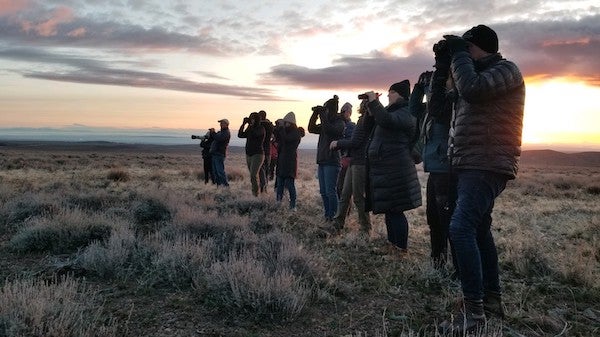Boise State University hosted the conference of the Society of Environmental Journalists April 19-22 and introduced Boise State research to more than 840 journalists, policy makers, Tribal members, researchers and the environmentally passionate from across the country.
According to event personnel, the conference held on campus was the largest conference since 2011.
Emily Wakild, a professor of history and the Cecil D. Andrus Endowed Chair for Environment and Public Lands, coordinated many of the Boise State academic logistics for the event with conference co-chair and Boise State Public Radio general manager Tom Michael.
“What an opportunity to highlight the reach and sophistication of Boise State’s environmental research,” Wakild said. “Public lands in our state are a crucible for democracy and a laboratory for ecological resilience. We worked to help journalists see the complexity of issues from the dark sky, to the salmon in our rivers, and the soil beneath our feet.”
A highlight of the conference were tours led by Boise State faculty and student environmental experts, and Boise State Public Radio journalists.

On April 20, conference attendees rose before sunrise and drove into the sagebrush steppe to join biology faculty Jen Forbey at a sage grouse breeding ground (known as a lek). There, journalists from major national outlets witnessed firsthand the unique display of the male sage grouse courtship.
“They were super excited,” Forbey said. “I think the majority of the participants had never seen a sage grouse before. We got to see 44 birds, and pronghorn walking across the mating display ‘stage’, with deer in the background. It was really just beautiful.”
Additionally, Forbey was able to share her expertise about how the quality of sagebrush impacts the nutrition of species like sage grouse, pygmy rabbits and pronghorn. Multiple participants told Forbey that they had never before realized how selective animals are about food sources and quality.
In addition to gaining first-hand experience, the tour also included conversation about the changes in the landscape, and land management efforts to keep the birds in their native habitat. Following, the tour also featured a panel discussion about what is known about sage grouse and the goal to keep them from getting listed as endangered species.
In another tour themed “Agriculture, climate change and the lives of farmworkers,” Uwe Reischl, a professor in the School of Public and Population Health, presented his research to a bus full of eager journalists.
“My topic was to address management of farmworker heat stress during hot summer months for the SEJ journalist group who wanted to experience the lives and working conditions of farmworkers. It was a unique experience for me giving a presentation on the bus, but I think the 60 journalists on the bus found it informative and interesting,” said Reischl.
“The tours hosted by our faculty illuminated the environmental challenges we have in the West for the journalists. And the response we received from the journalists only reinforced the ‘why’ of our new School of the Environment,” said Nancy Glenn, Vice President for the Division of Research and Economic Development. “Together, Boise State and communities such as SEJ can work together to develop the science and knowledge that we all need to manage for resilient western landscapes.”